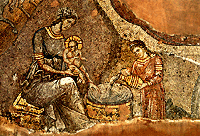 |
|
 |
Numerical data
 he Late Byzantine period
he Late Byzantine period
 is characterised by demographic decline and by the wretchedness of the rural population. On the basis of the information we possess, dating mostly from the end of the 13th and from the 14th century, we can observe that the number of individuals constituting a household dropped from an average of 4.7 to 3.7. We can also see that, although the villages in general showed a decrease in population, there did occur, from time to time, a certain differentiation between them, as a number of villages might present a considerable decrease in population, or even be completely deserted, while others might show an important increase. This phenomenon is mostly observed in times of enemy invasions or civil wars, since the villages that lay in the path of the invaders were evacuated, while others that were in a safer position constituted poles of attraction, which brought about an upsurge of their population. is characterised by demographic decline and by the wretchedness of the rural population. On the basis of the information we possess, dating mostly from the end of the 13th and from the 14th century, we can observe that the number of individuals constituting a household dropped from an average of 4.7 to 3.7. We can also see that, although the villages in general showed a decrease in population, there did occur, from time to time, a certain differentiation between them, as a number of villages might present a considerable decrease in population, or even be completely deserted, while others might show an important increase. This phenomenon is mostly observed in times of enemy invasions or civil wars, since the villages that lay in the path of the invaders were evacuated, while others that were in a safer position constituted poles of attraction, which brought about an upsurge of their population.
Comparing the results of the censuses of the Late Byzantine period, we find that men outnumber women. Several
 explanations have been given for this by researchers, the prevailing one being that which attributes the fact to the incomplete data recorded with regard to women. explanations have been given for this by researchers, the prevailing one being that which attributes the fact to the incomplete data recorded with regard to women. During the Late Byzantine period, the average life
expectancy appears to have been 45-50 years, while infant mortality below
the age of five years was particularly high. As we move from the beginning
to the middle of the 14th century, the average number of children per
couple falls from 3.5 to 2 at the most. As time went by, the number
of young people dropped and the number of middle-aged or elderly
people increased. This inevitably brought about a decrease in
the proportion of the active population but also of those who
were of a biologically reproductive age.
|